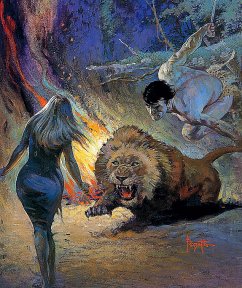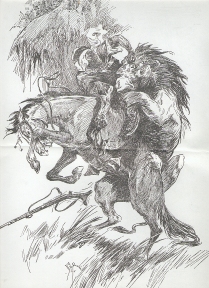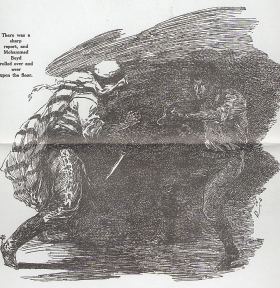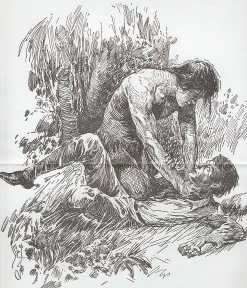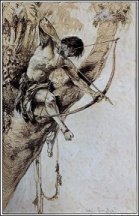The nature of the story changes from
the departure of Werper and Jane from Achmet Zek's camp . To that
point the story had been developed in a linear fashion. From Zek's
camp on ERB either loses control of his story or changes into an aggregation
of scenes between the camp and the Estate leading to the return.
Perhaps there is a modification in his psychology.
The struggle for the possession of the jewels
and the woman continues unabated. As always Burroughs tries to construct
a story of many surprising twists and turns. This may be an influence
of the detective story, Holmes, on him. He may be trying to emulate
Doyle.
The problem of who the characters represent
in ERB's life becomes more difficult to determine. Werper continues
as ERB's failed self. I think as relates to Zek and the jewels, Zek
represents Burroughs' old sexual competitor, Frank Martin, while Zek, the
gold and the Abyssinians represent the deal between McClurg's and
in 1914-15, A. L. Burt. Burt first had the reprint rights to Tarzan
Of The Apes, published in the summer of 1914. Those rights shortly
passed to Grossett and Dunlap.
In my estimation Martin never ceased interfering
with Burroughs' marriage, at least from 1900 to 1919 when Burroughs fled
Chicago. We suspect that Martin tried to murder Burroughs in 1899
and that his pal, R.S. Patchin, looked up Burroughs in LA after the divorce
in 1934 and sent a mocking condolence letter in 1950 when Burroughs died
and after Martin had died sometime earlier. Patchin would obviously
have been directed by Martin to taunt Burroughs in '34. It's clear
then that Martin carried a lifelong grudge against Burroughs because of
Emma.
Martin is thus portrayed as being in competition
with Burroughs in 1914-15 and possibly, but probably to a lesser extent,
in LA.
Jane is shown being captured by Zek twice in
the story. Thus Emma was courted or captured by Martin when Burroughs
was in Arizona and Idaho. In this story Jane is captured while Tarzan
is absent in Opar. The second capture or courting by Martin is diffiicult
to pinpoint by the inadequate information at our disposal, but following
the slender lead offered by the novelist, John Dos Passos, in his novel
The
Big Money I would think it might be in 1908 when ERB left town for
a few weeks or months probably with Dr. Stace. It was of that time
that the FDA (Federal Food And Drug Administration) was after Stace for
peddling his patent medicines. Burroughs was probably more deeply
involved with that than is commonly thought. At any rate his being
out of town would have provided an opportunity for Martin. Whether
something more current was going on I don't find improbable but I can’t
say.
I would also be interested to learn whether
there was any connection between McClurg's and Martin. Martin was
Irish, his father being a railroad executive, which explains the private
rail car at his disposal, as were, of course, the McClurgs and so was the
chief executive Joe Bray. If Martin knew Bray he might have pressured
Bray to reject publication of Tarzan doing a quick turnaround when
interest was shown by the Cincinatti firm. Martin then might have
meddled with Burroughs' contract with McClurg's. The contract and
McClurg's attitude is difficult to understand otherwise.
The gold is buried, which Zek is supposed to have gotten through Werper,
then they have a falling out and Werper is captured by Mourak and his Abyssinians.
Mourak would then represent A.L. Burt and a division of the the royalties.
If McClurg's had promoted Tarzan Of The Apes, which they didn't,
Burroughs would have received 13 cents at $1.30 per copy. Thus at even
100,000 or 200,000 copies he would have received 13,000 or 26,000 dollars.
that would have been a down payment on his his yacht. Martin who must have
thought of Burroughs as a hardcore loser from his early life would have
been incensed by such good fortune.
Instead, it doesn't appear that McClurg's
even printed the whole first edition of 15,000 copies. The book immediately
went to A.L. Burt where the price of the book was reduced to 75 or 50 cents
with the royalty much reduced to 4 1/2 cents divided fifty-fifty between
McClurg's and Burroughs. It's hard to believe that ERB wasn't robbed
as he certainly thought he had been. Thus when Mourak unearths the
gold he is settling for a portion of the hoard when Zek's men show up and
the battle necessary for the story begins.
In this manner the key issues of gold, jewels
and woman are resolved.
So, Werper with the jewels goes in search of
Jane to find that she has already fled Zek's camp. The scenes of
the story now take place between the camp, perhaps representing McClurg's
offices and the Estate, representing Burroughs.
The latter half of the book, pages 81-158
in the Ballantine paperback is very condensed, in a dream-like fashion.
The action within the very prescribed area with a multitude of people and
incidents is impossible except as a dream story. The appearance of
the Belgian officer and askaris must have been photoshopped it is so impossible.
In other words, then, the whole last half of the book, if not the whole
book, is a dream sequence in which dream logic prevails. I will make
an attempt to go into late nineteenth century dream speculation in Part
V.
A key point of the story is the regaining of
the memory of Tarzan. This occurs near story's end on page 139 and
following. It's fairly elaborate. In connection with his memory
return I would like to point out the manner of his killing the lion when
he rescues Jane from Mourak's boma. The roof fell on Tarzan in imitation
of his braining in Toronto, while now he picks up a rifle, swinging it
on the rearing lion's head, splintering the stock along with the lion's
skull so that splinters of bone and wood penetrate the brain while the
barrel is bent into a V. Rather graphic implying a need for vengeance.
Not content with having the roof fall on Tarzan's head while trying to
escape the Belgian officer, an askari lays him out with a crack to the
back of the head but 'he was unhurt.' One can understand how Raymond
Chandler marveled. My head hurts from writing about it. Also
Chulk has his head creased by a bullet adding another skull crusher to
the story.
The description of the return of Tarzan's reason
seems to fit exactly with Burroughs' injury. I would have to question
whether Burroughs himself didn't have periods of amnesia. P. 139:
Vaguely the memory of his apish childhood
passed slowly in review -- then came a strangely tangled mass of faces,
figures and events that seemed to have no relation to Tarzan of the Apes,
and yet which were, even in this fragmentary form, familiar.
Slowly and painfully recollection was attempting
to reassert itself, the hurt brain was mending, as the course of its recent
failure to function was being slowly absorbed or removed by the healing
process of perfect circulation.
According to medical knowledge of his time the
description seems to apply to his own injury. His own blood clot
had either just dissolved or was dissolving. Then he says almost
in the same manner as in The
Girl From Farris's:
The people who now passed before his
mind's eye for the first time in weeks were familiar faces; but yet he
could neither place them in niches they had once filled in his past life
nor call them by name.
In this hazy condition he goes off in search of
the She he can't remember clearly. His memory fully returns as he
has Werper by the throat who calls him Lord Greystoke. That and the
name John Clayton bring Tarzan fully back to himself. For only a
few pages at the end of the book does he have his memory fully recovered.
In order to summarize the rest I have had to
outline the actions of the main characters for, as with Tarzan and his
memory, the story is one of 'a strangely tangled mass of faces, figures
and events.' Whether this is artistry on Burroughs' part or a dream
presentation I am unable to ascertain for certain. Let's
call it artistry.
We will begin with Werper's activities.
While Tarzan promised to retrieve La's sacred knife Werper appears to no
longer have it as it disappears from the story. When Werper escaped
from Zek, unable to locate, Jane he heads East into British territory.
He is apprehended by one of Zek's trackers. On the way back a lion
attacks the Arab unhorsing him. Werper mounts the horse riding away
directly into the Abyssinian camp of Mourak. Mugambi is captured
at the same time. While the troop bathes in a river Mugambi discovers
the gems managing to exchange them for river pebbles. Werper tempts
Mourak with the story of Tarzan's gold. While digging the gold
they are attacked by Zek and his men. Werper rides off as Mourak
is getting the worst of the fight. Zek rides after him. Werper's
horse trips and is too exhausted to rise. Using a device that ERB
uses in one of his western novels Werper shoots the horse of the following
Zek, crouching behind his own for cover. Zek has lost the woman but
now wants the jewels. Werper hasn't the woman while unknown
to himself he neither has the jewels. In exchange for his life he
offers Zek the pouch of river stones believing it contained the jewels.
Zek accepts. Both men are treacherous. Werper waits to shoot
Zek but Zek out foxes him picking up the bag by the drawstring with his
rifle barrel from the security of the brush.
Discovering the pebbles he thinks Werper has
purposely deceived him stalking down the trail to finish him off.
Werper is waiting and pots him with his last shell. As Zek falls,
the woman, Jane, appears as if by a miracle reuniting the two. Could
happen I suppose but definitely in dreams.
So, what are the two men fighting over?
The sex interest as the jewels are involved. Who do Werper and Zek
represent? Obviously Burroughs and Martin. The stones are false,
but as Werper disposes of Zek in the competition for the woman Jane appears
as if by magic to run to Werper/Burroughs with open arms.
Werper with Jane returns to Zek's camp now
under the direction of Zek's lieutenant, Mohammed Beyd. Rigamarole
and Werper deposit Jane in a tree from whence he expects to retrieve her
on the following morning. The next day she is gone.
Werper once again turns East. He is spotted
by Tarzan riding along. The Big Guy falls from a tree throwing Werper
to the ground demanding to know where his pretty pebbles are. It
is at this point Werper recalls Tarzan to his memory by calling him Lord
Greystoke. Also at the moment the Belgian officer appears from nowhere,
having miraculously ascertained Werper's whereabouts, to arrest him.
Tarzan wants Werper more than the Belgian,
so tucking his man under his arm he breaks through the circle of askaris.
On the point of success he is brought down from behind. Another thwack
on the head. Apparently in a desperate situation Tarzan hears voices
from the bush. The Great Apes have their own story line but here
it is necessary to introduce them as Tarzan's saviors. The voice
is from Chulk who Tarzan sends after the troop. They attack routing
the Africans. In the process Chulk, who is carrying the bound Werper,
is shot. If you remember, Chulk stole the stones from Mugambi, or
maybe I haven't mentioned that yet. Werper falls across him in such
a way that his hands bound behind his back come into contact with the pouch.
Werper quickly recognizes what the bag contains although he has no idea
how the ape came by them.
He then advises Tarzan where he left Jane.
The two set out when the furore in Mourak's camp reaches his ears.
"Jane might be involved," says Werper. "She might," says Tarzan,
telling Werper to wait for him while he checks.
Werper waits not, disappearing into the jungle
where his fate awaits him.
Those are the adventures of only one character
in this swirling vortex of seventy some pages.
Let's take Mugambi next as he is the key to
the story of the jewels yet plays a minor role. After crawling after
Jane and regaining his strength he arrives at Zek's camp at the same time
as Tarzan and Basuli but none are aware of the others. Werper and
Jane have already escaped when Tarzen enters the camp to find them missing.
Mugambi follows him later also finding both missing. He goes in search
of Jane. He walks through the jungle ludicrously calling out 'Lady’'after
each quarter mile or so. Leathern lungs never tiring he shouts
Lady into the face of Mourak and is captured. Being a regular lightfoot
he escapes, having lifted the jewels from Werper. Chulk then lifts
them from him, Mugambi disappears until story's end.
Let's see: Jane next. Jane
along with the jewels is the key to the story. The jewels represent
the woman as man's female treasure. Jane is the eternal woman in
that sense. The various men's attitude toward the jewels reflects
their own character. Thus, Tarzan in his amnesiac simplicity wants
the jewels for their intrinsic beauty. He rejected the uncut stones
for the faceted ones in Opar. Even in the semi darkness of the vaults,
or in other words, his ignorance, he perceived the difference.
Werper at various times thinks he can get the
gold, the jewels and the woman at once. He is happy to settle for
the jewels taking them to his grave. Mourak knowing nothing of the
jewels is willing to settle for a few bars of gold. When he takes
the woman into his possession it is for the sole purpose of a bribe to
his Emperor to mitigate his overall failure. Not at all unreasonable.
Zek is too vile to consider as a human being
dying in the fury of losing all. Mugambi and Basuli are happy in
their devotion to the woman to whom neither jewels or gold mean anything.
Tarzan then, pure in soul and spirit wins it
all, woman, jewels, and gold. One is tempted to say he lived happily
forever after but, alas, we know the trials ahead of him.
So Jane is carried off to Zek's camp where
all the action is centred while she is there. Both Tarzan and Mugambi
show up to rescue her but she has escaped just ahead of Werper who would
thus have had the woman and the jewels. Alone in the jungle she once
again falls into Zek's hands -- that is to say those of Frank Martin.
Now, Tarzan, who has fallen in with a
troop of apes chooses two, Taglat and Chulk, to help him rescue Jane from
Zek. Chulk is loyal, but Taglat is an old and devious ape, apparently
bearing an old grudge against Tarzan, who intends to steal Jane for his
own fell purposes much worse than death.
In Tarzan's attempt to rescue Jane, Taglat
succeeds in abducting her. He is in the process of freeing her bonds
when a lion leaps on him. In the succeeding battle Jane is able to
escape the lion who had just killed Taglat.
Wandering through the jungle she hears
shots, the voices of men. Approaching the noise she discovers Werper
and Zek fighting it out. She climbs a tree behind Werper. When
he shoots Zek he hears a heavenly voice from above congratulating him.
Jane runs to him hands outstretched. So now Werper has the
woman again while believing he can retrieve the jewels. He can't
find them because unbeknownst to him Mugambi had substituted river rocks.
Improbably, except in a dream, he returns
to Zek's camp where he has to solve the problem of Zek's second in command,
Mohammed Beyd. Werper spirits Jane out of the camp but finds her
gone the next morning. She had mistaken Mourak and his Abyssinians
for Werper. Mourak, now in possession of the woman, but with no gold
no jewels, thinks to redeem himself with his Emperor, Menelik II, with
this gorgeous female.
During that night's camp the boma is attacked
by hordes of lions. Lions play an amazingly central role in this
story. Interestingly this scene is replicated almost exactly in the
later Tarzan and the City Of Gold. In Jewels Tarzan
rescues a woman while in Gold Tarzan rescues a man. That story's
woman becomes his enemy.
But now Tarzan and Werper hear the tremendous
battle with Tarzan entering the boma to rescue Jane. By the time
of the rescue Tarzan has regained the woman and the gold but lacks the
jewels.
Unless I’m mistaken we now have only Tarzan
and the apes to account for.
ERB's life was at a turning point. At
this stage in his career he must have realized that he would have a good
annual income for the rest of his life. If only 5000 copies of the
first edition of Tarzan of the Apes sold he would have received
$6,500.00 Add his magazine sales to that and other income and 1914
must have equaled his income of 1913 or exceeded it. His income probably
grew until he was earning c.$100,000 per year for three years from 1919-1922.
So he had every reason to believe the world was his oyster through the
teens. That must have been an exhilarating feeling. A sense
of realization and power must have made him glow. But the period
was one of transition, a casting off of the old skin, while growing into
the new. Thus one sees ERB abandoning his old self - Werper - while
attempting to assume the new in Tarzan. Thus in death, Werper transfers
the jewels, call them the Family Jewels, from himself to Tarzan.
Tarzan begins the novel as an asexual being
unaware of what jewels were or their value and receives them at the end
of the novel as a release from emasculation or awareness of his sexual
prowess. Once again Werper fades in the novel, while Tarzan, unaware
of who he is comes to a full realization. Presumably Burroughs thinks
he is able to assume his new role as 1915 ends.
In the novel when Tarzan realizes Werper has
stolen the jewels he goes off in search of this symbol of his manhood.
Werper is not in Zek's camp. On the trail Tarzan comes across the
dead body of the Arab sent after Werper with his face bitten off.
He assumes this is Werper but can't find the jewels. Wandering about
he discovers a troop of apes and he decides to run with them for a while.
Selecting Chulk and Taglat he goes back to Zek's camp to rescue Jane.
At that point Taglat makes off with Jane. Discovering Zek and Werper
on the way to the Estate Tarzan becomes involved in the battle between
Zek and Mourak. He sees Zek take the jewels and then throw them to
the ground as worthless river rocks.
He encounters Werper in the jungle again
and, prompted by the man, fully regains his memory only to have Werper
arrested by the Belgian police officer. The battle between Mourak
and the lions ensues. Tarzan goes to rescue Jane, Werper goes to
his death.
The unarmed Tarzan faces a rampant lion.
Picking up an abandoned rifle he brains the lion, apparently in vengeance
for all the indignities and injuries ERB has suffered in life.
Leaping with Jane into a tree they begin the
journey back to the Estate to begin life anew. Some time later they
come across the bones of Werper to recover the jewels and make the world
right.
The novel closes with Tarzan's exclamation.
"Poor
devil!" …Even in death he has made restitution - let his sins lie with
his bones."
Was Burroughs speaking of Werper as his own failed
self? I believe so. Remember that a favorite novel of ERB was Dr.
Jekyll and Mr. Hyde and that he believed that every man was two men
or had two more or less distinct selves. Human duality is one of
the most prominent themes in the corpus; thus ERB himself must have believed
that he had a dual personality. Tarzan will have at least two physical
doubles, one is Esteban Miranda in Golden Lion and Ant Men,
and the other Stanley Obroski in Lion Man. Both were failed
men as Werper is here. Both obviously represented the other or early
Burroughs as Werper does here.
In killing Werper ERB hoped to eliminate the
memory of his failed self as he did with Obroski in Lion Man.
In other words escape his emasculation and regain his manhood.
The jumbled and incredibly hard to follow,
or at least, remember, last half of the book with its improbable twists
and turns in such a compressed manner gives the indication that this is
a dream story. Only dream logic makes the story comprehensible if
still unbelievable. The story then assumes fairy tale characteristics
that don't have to be probable to be understood as possible.
Can be genius, can be luck. I will examine
Burroughs novels in relation to dreams in Part V. This part will
not be as comprehensive as I would like but time grows short and it is
better to make the attempt as not.
Part V follows.

